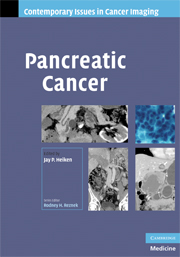Book contents
- Frontmatter
- Contents
- Series Foreword
- Preface to Pancreatic Cancer
- Contributors
- 1 Epidemiology and genetics of pancreatic cancer
- 2 Pathology of pancreatic neoplasms
- 3 Multi-detector row computed tomography (MDCT) techniques for imaging pancreatic neoplasms
- 4 Magnetic resonance imaging (MRI) techniques for evaluating pancreatic neoplasms
- 5 Imaging evaluation of pancreatic ductal adenocarcinoma
- 6 Imaging evaluation of cystic pancreatic neoplasms
- 7 Imaging evaluation of pancreatic neuroendocrine neoplasms
- 8 Role of endoscopic ultrasound in diagnosis and staging of pancreatic neoplasms
- 9 Surgical staging and management of pancreatic adenocarcinoma
- 10 Treatment of locally advanced and metastatic pancreatic cancer
- 11 Rare pancreatic neoplasms and mimics of pancreatic cancer
- Index
- Plate section
- References
5 - Imaging evaluation of pancreatic ductal adenocarcinoma
Published online by Cambridge University Press: 23 December 2009
- Frontmatter
- Contents
- Series Foreword
- Preface to Pancreatic Cancer
- Contributors
- 1 Epidemiology and genetics of pancreatic cancer
- 2 Pathology of pancreatic neoplasms
- 3 Multi-detector row computed tomography (MDCT) techniques for imaging pancreatic neoplasms
- 4 Magnetic resonance imaging (MRI) techniques for evaluating pancreatic neoplasms
- 5 Imaging evaluation of pancreatic ductal adenocarcinoma
- 6 Imaging evaluation of cystic pancreatic neoplasms
- 7 Imaging evaluation of pancreatic neuroendocrine neoplasms
- 8 Role of endoscopic ultrasound in diagnosis and staging of pancreatic neoplasms
- 9 Surgical staging and management of pancreatic adenocarcinoma
- 10 Treatment of locally advanced and metastatic pancreatic cancer
- 11 Rare pancreatic neoplasms and mimics of pancreatic cancer
- Index
- Plate section
- References
Summary
Introduction
In Western countries, pancreatic ductal adenocarcinoma (pancreatic cancer) is the 4th–5th leading cause of cancer-related death, with over 200 000 cases annually. In the USA, it is estimated that 33 370 deaths resulted from pancreatic cancer in 2007 [1].
Clinical presentation of pancreatic ductal adenocarcinoma depends on its location. Because there are no reliable clinical or laboratory parameters to detect lesions early in the course of the disease, approximately 80–90% of patients with pancreatic adenocarcinoma present at an advanced stage (III or IV). Approximately 60–70% of these malignancies arise in the pancreatic head, and most come to clinical attention when patients present with weight loss and painless jaundice. The remainder, which arise in the body, tail or uncinate process, usually are clinically occult until a late stage when patients often present with non-specific symptoms such as weight loss or back pain [2].
Surgical resection of ductal adenocarcinoma offers the only chance for cure in the 10–20% of patients who present at an early stage (I or II). Patients who undergo complete surgical resection of the primary mass have improved 5-year survival [3].
As with detection, no reliable clinical or laboratory tests are available to predict cancer stage and determine the potential for surgical resection in a given patient [2–5]. Surgical triage of patients is predicated on accurate preoperative imaging to maximize benefit for potentially resectable patients and to spare potentially morbid surgery (in up to 20% of attempted resections) for those with advanced stage disease that is unlikely to be resectable [6,7].
- Type
- Chapter
- Information
- Pancreatic Cancer , pp. 58 - 82Publisher: Cambridge University PressPrint publication year: 2008



